
Sleeping beauties.
Ah yes, the Temperate Zone. Life is good in the Temperate Zone. We get cold air in Winter, warm air in the Spring and Fall, and hot, humid conditions in Summer. It’s got a bit of everything and makes for nice contrasts in which to punctuate the passage of the year. But as a cigar collector, the disparate seasonal conditions of living in North America can present seasonal challenges to keeping our sticks in good smoking order. Now that it’s summer, keeping our cigars cool is important and too much humidification can cause our sticks to get dangerously moist. With the rise in ambient RH (relative humidity) and higher temperatures come an increased risk of cigar mold and the heart-breaking potential of ruined cigars.
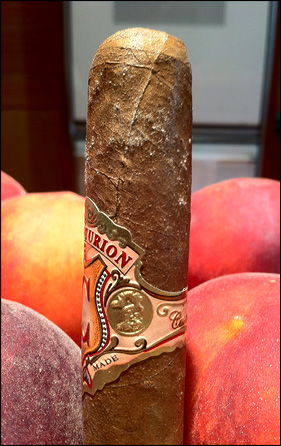
Mold or bloom? I had to know for sure.
Now that my Cigar Closet has made it successfully through the cool weather, the danger of summer has reared its fuzzy head, and I find myself confronted with a difficult situation. Upon returning from a recent vacation, I was shocked to see that some of my cigars had grown white mold. I had built my Cigar Closet to avoid the headaches of desktop cigar storage, only to now find myself with similar problems but on a grander scale. I needed to act fast to stem the rising tide of destruction and find out why, and from where, the mold had appeared. It has now been months since this problem first arose and I am still groping for answers. Below is an accounting of my trials and tribulations, and what I have learned, so far, about mold and cigar storage. This is my story…
In the beginning…
Ignorance may be blissful, but for cigar storage, vigilance is imperative. I know from experience that almost daily inspection of my desktop cigar humidors was the best way to insure all was well with my sleeping beauties. And after years of successful desktop cigar storage, I had a pretty good idea what to do when building a Cigar Closet. My plan was to simply construct the equivalent of an oversized desktop humidor, applying the same principles of construction and maintenance. As it turns out, my thinking was generally good, but not airtight.
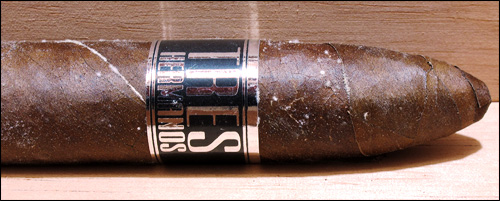
Trouble in Paradise.
Bloom, plume, or moldy doom?
In dealing with my mold issue, I first needed to find out if my cigars were ruined. Over the years I’d discovered that a bit of white mold isn’t harmful and have smoked cigars in that state without suffering dire consequences. But Internet research on this subject yields so much misinformation and confusion that it led me to question something I thought I had already understood: was this white stuff cigar mold or cigar bloom1 (or plume)?
As it turns out, many people confuse white cigar mold with cigar bloom. Some respected industry people have gone so far as to say, “If it’s white then it is bloom”. But I have had REAL cigar bloom and know that it is a light dusting of shiny crystals that reflect light. Mold, on the other hand, has fuzzy blotches that are raised up above the cigar wrapper. I knew in my heart that my sticks were moldy, but was hoping otherwise.
But not all molds are created equal. White mold is harmless and will brush off easily. Blue or black mold on the other hand is highly toxic and can ruin an entire cigar collection. Plus, mold spores can get airborne and spread from one cigar to another so affected cigars must be quarantined or disposed of. In my case, I took the few moldy sticks, cleaned them up and put them in a cigar box in the driest part of the Cigar Closet. After a few days in 65% RH, I smoked the biggest offender. To my surprise, that cigar had outstanding flavor. It was a great cigar to begin with (a Tres Hermanos torpedo), and the white mold caused no ill affects. One might even surmise that the mold enhanced the cigar flavor, but I won’t go that far. So it’s easy to see why white mold could be confused with bloom. Understanding that white mold is harmless has given me a bit of solace and I think my cigars will survive, but why did they get moldy in the first place? I needed more information.
Seeking professional help.
In order to move ahead, I felt I needed to see exactly what was happening to my cigars. I contacted ISCT mold inspectors and scheduled an examination of my closet and home. Within a few days, Collin the mold inspector was here taking samples. My home looked and smelled okay (he said my basement smelled “sweet” and seemed to rather enjoy it down there), but sent two samples to the lab. One was the moldy wick element of the humidifier2. (This was actually the second wick I had tried, and in both instances, both black and white mold contaminations became evident within weeks of operation.) The other sample was a Pepin El Centurion Robusto, which had only a light dusting of white mold (see photo above). This was a BIG sacrifice but it had to be done. At that time it was the only moldy stick I could find.
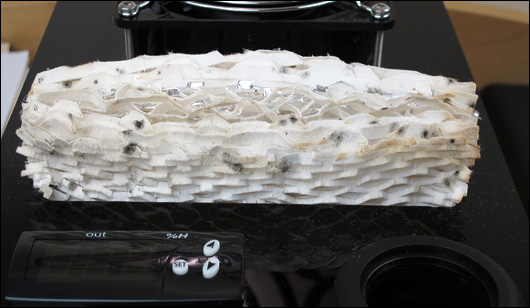
Cladosporium on the humidifier wick
Within a few days the results came in and they were not surprising. Both samples were positive for mold contamination: Cladosporium and Penicillium/Aspergillus. Cladosporium was the black mold found on the wick, while the cigar had only the white Penicillium/Aspergillus. These are common outdoor molds that proliferate in the summer months. Although Los Angeles has a desert climate, irrigation has provided the means for a year round mold-growing season. As a result these mold spores are everywhere and tend to grow on moist vegetable matter…cigars are virtual petri dishes for mold spores. It was going to be an uphill battle to keep these spores away from my cigars.
Solution #1:
Karen, the office manager at ISCT suggested I use a HEPA filtration system to catch the airborne mold spores. This sounded like a good approach and I was able to find a small unit for about $75. But my hopes were quickly dashed the first day I put the unit to work. Within a few hours of operation (on the lowest setting), the temperature in the closet rose to 77 degrees. This was above my comfort zone and I figured the temperature would climb even higher if the unit continued to run. Although cool to the touch, it appeared the unit’s fan was warm enough to heat the air in the confined space of the closet. This was disappointing and I removed the humidifier posthaste. But the biggest shock was the immediate effect the additional heat had on the cigars. Within 36 hours of being exposed to just that small increase in temperature, the cigars had succumbed to mold at an accelerated rate. This was not good. I now know from first hand experience that higher temperatures encourage mold growth. (Well, duh, isn’t that why we put bread in the fridge?!) Now what?
The 70/70 rule…a closer look.
Most articles written about cigars recommend storage conditions of 70 degrees Fahrenheit, and 70% RH. I have been vigilant in this regard and these guidelines had served me well when my cigars were in desktop humidors. Yet when I made a survey of how large cigar vendors stored their cigars (we’re talkin’ tens of thousands of boxes), I was surprised to find that every company stored their inventory at 65 degrees and 65% RH. This ran contrary to all I had read and left me a bit confused. I knew from experience that 65% RH was great for conditioning cigars just prior to smoking, but wasn’t 65% dangerously low for long-term storage? This got me thinking…perhaps 70% RH was, in fact, too high for mold-free cigar aging? (Sidebar: Karen had told me that mold can occur in as little as 50% RH). With that in mind, my next step towards Cigar Closet rehabilitation was to remove the humidifier, thereby lowering the RH within the closet. If mold were caused by excessive moisture, this would be the most logical step.
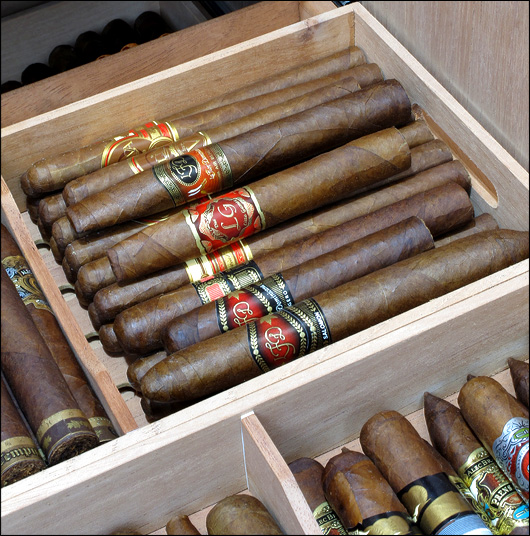
Gotta keep these babies safe!
Now we are getting somewhere!
To my delight, as soon as the closet dropped to around 67% RH, the cigars stopped growing mold. Additionally, the humidity remained stable for weeks after removal of the humidifier, and no additional humidification was needed. BUT…the cigars had lost that wonderful barnyard aroma, and tasted less rich than before. The question now was could I reach a compromise? Would it be possible to maintain my cigars just below the “mold threshold” and get back some of that wonderful aroma and richness? In an effort to reach this “sweet spot”, I reintroduced the humidifier. But before doing so I cleaned it, dried it, and (this time), omitted the wick. I wasn’t taking any chances if the wick was somehow contributing to the problem.
Be afraid, be very afraid.
Today, I think I have finally fallen into a groove with this cigar-conditioning thing. It has been weeks since I introduced the “wickless” humidifier and with it set at 69% (down just one percent from 70%), the cigars are beautifully moist, yet mold free. But I’m taking a very cautious approach. I think I am right on the brink of the mold threshold and am inspecting the sticks daily. I now understand why big cigar vendors keep their inventory at 65/65 and feel the 70/70 rule is better suited for desktop humidors; their less efficient moisture retention may require additional humidity.
Of all the lessons learned during this Cigar Closet experiment, one stands out above the rest: cigar storage, on any level, requires very careful monitoring and continuous adjustments to temperature and humidity. Finding and maintaining that “sweet spot” is difficult and mold can appear even under ideal conditions. In the past my Tuppordore system worked well, and keeping my desktop humies in cabinets helped guard against seasonal climatic changes. But the number of units I accumulated had gotten out of hand and I needed centralized storage. In building the Cigar Closet I have minimized maintenance by keeping all my cigars in one place, but have needed to address familiar cigar storage issues albeit in a new context. There is no doubt that the Cigar Closet has benefits that I enjoy everyday, but it is not immune to seasonal conditions. If I were to aim towards a “set and forget” storage scenario I would probably have to air condition the closet, but that would add expense and another layer of complexity. I have tried expensive “set and forget” cigar storage units like the Monolith 1200 but found it to have uneven humidification and it too, allowed some cigars to get moldy.
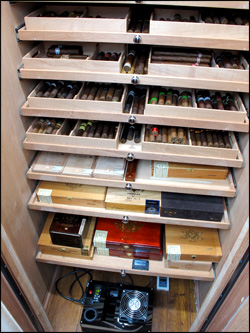
Finally back in a healthy groove.
And in the end.
The bottom line seems to be that if you are a very picky cigar smoker, like myself, cigar storage can be frustrating and a bit scary. On one hand I wish I could just relax and not be such a stickler for perfection, but that is simply not who I am. Making periodic adjustments to control the RH will have to be a way of life for me, even with a beautiful cedar lined Cigar Closet; to be remiss in my vigilance is simply not an option. I like my cigars “just so” and as a result may have doomed myself to a life of cigar angst. But like Popeye once said, “I yam what I yam”…and I guess I’ll just have to live with that.
Thanks for listening,
Joe
1 Bloom (or plume) is a harmless condition whereby the tobacco oils contained in a cigar will crystallize. This is a rare occurrence and some consider it a good thing. I have found it to have no beneficial effect on cigar flavor whatsoever.
2 The wick is absorbent material that draws water up into a humidifier. A fan will then pull moist air through it and out of the humidifier housing.







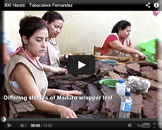
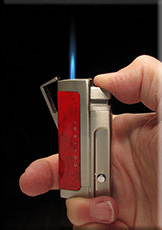

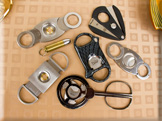

Very helpful – thanks.
Pics not showing up.
Sorry about that. This new site in undercontruction. Pics will be visible soon. Thanks for the comment.
That is a beautiful closet. But for long term storage, consider wineadors. Get them while on sale. They offer excellent seal and temperature control. You living where you live, you definitely need temperature control. I keep the long term storage wineadors with the cigar boxes around 64 degrees and 64 percent humidity and allow the loose cigars for short term usage as high as 67/67. Best cigar money I’ve ever spent.
I’ve considered adapting wine coolers, but I would need ten of them to accommodate all my cigars.